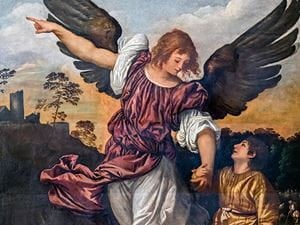
Pictures of angels are everywhere. They decorate cards, balloons and notepads. Statues of them sit in gardens, on desks, in bedrooms and next to the fine china. They are found in many classical paintings, murals and sculptures. Regardless of where they are found, angels are almost always depicted in the same way: a young man or woman with feathery wings and a gentle expression who is wearing a shapeless white robe or gown. This is not, however, the image that the Bible gives us.The mental image that most people have of angels is born from famous paintings and repeated exposure to the popular image of angels. When a person examines the Bible, however, they get a rather different picture.
Popular images of angels tend to make them appear gentle, kind and comforting. There is a reason that someone innocent and sweet is described as “angelic.” The Bible, however, does not hold to that idea. Almost every time that angels appear in the Bible, they preface their words with “do not be afraid.” In many of these cases, there is no physical description of the angel. The fact that they must warn people against being afraid, however, suggests that their appearance is in some way shocking or frightening. It could be their sudden appearance that startles humans, but people generally calm down when they see that whatever startled them does not look frightening. That does not seem to be the case with many angels.Even when angels are portrayed in popular culture as warriors, they are still depicted as beautiful humans. Archangel Michael, for example, is often shown as a beautiful man with a fierce or focused expression. Some angels do hold to this description. Mark 16, for example, states that the angel who was waiting for the women at the tomb looked like “a young man…clothed in a white robe.” This may be where the common depiction of angels as young people in white began. Similarly, John 20 states that the angels in the empty tomb were dressed in white.
Modern depictions of angels often show them holding a harp or trumpet or singing. This both does and does not fit with the descriptions of angels found in the Bible. The Gospel of Luke describes angels as singing to celebrate the birth of Christ, and Revelation has several instances where angels are said to carry and sound trumpets that herald disaster for mankind. Other angels in Revelation, however, carry a variety of tools. They have sickles, scrolls, censers and swords. In fact, the most common object that angels carry in the Bible is a sword. The angel of the Lord described in Numbers is said to have carried a sword as did the angel in 1 Chronicles.
The angels in the New Testament tend to be much closer to the appearance of angels that most people are trained to expect. The Old Testament, however, has multiple instances where angels look anything but gentle, sweet and beautiful. In fact, some of them do not even look human.
Ezekiel 1 has one of the most detailed descriptions of angels in the entire Bible. His term for them is “living creatures” instead of “angel,” but they are commonly accepted to have been a form of angel. They do not, however, even remotely resemble what most people envision. “Their form was human, but each of them had four faces and four wings. Their legs were straight; their feet were like those of a calf and gleamed like burnished bronze. Under their wings on their four sides they had human hands. All four of them had faces and wings, and the wings of one touched the wings of another. Each one went straight ahead; they did not turn as they moved…Each of the four had the face of a human being, and on the right side each had the face of a lion, and on the left the face of an ox; each also had the face of an eagle…They each had two wings spreading out upward, each wing touching that of the creature on either side; and each had two other wings covering its body… The appearance of the living creatures was like burning coals of fire or like torches. Fire moved back and forth among the creatures; it was bright, and lightning flashed out of it.”
Ezekiel is not the only prophet to have seen the more terrifying appearance of angels. The prophet Isaiah saw God seated on a throne in a temple with “seraphim, each [had] six wings: With two wings they covered their faces, with two they covered their feet, and with two they were flying.”
How angels appear to humans, however, is not always the same for even the same angel. Angels appear as human shaped beings, terrifying creatures and pillars of flame in the Bible. According to the book of Tobit, angels can take a variety of shapes based on what suits their needs. Raphael, for example, appeared to Tobit in the shape of a man with nothing about him that hinted he was an angel.
Popular depictions of angels do not quite fit with how the Bible describes angels. Instead of gentle, sweet and ethereal, biblical angels tend to be messengers of God brimming with His power. They may take a human form, but there is something about them that, unless they specifically conceal it, reveals the majesty of Him who sent them. Small wonder that they always have to tell the humans they visit, “do not be afraid.” Most people would be overwhelmed when facing a being who carries a message directly from God Himself.

